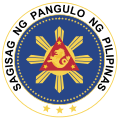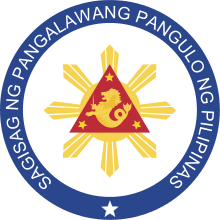Carlos P. Garcia
| His Excellency Carlos P. García | |
|---|---|
 | |
| 8th President of the Philippines | |
|
In office March 17, 1957 – December 30, 1961 | |
| Vice President |
None (March 17 – December 30, 1957) Diosdado Macapagal (1957–1961) |
| Preceded by | Ramón Magsaysay |
| Succeeded by | Diosdado Macapagal |
| 1st President of the 1971 Philippine Constitutional Convention | |
|
In office June 1, 1971 – June 14, 1971 | |
| President | Ferdinand Marcos |
| Succeeded by | Diosdado Macapagal |
| 4th Vice President of the Philippines | |
|
In office December 30, 1953 – March 17, 1957 | |
| President | Ramón Magsaysay |
| Preceded by | Fernando López |
| Succeeded by | Diosdado Macapagal |
| Secretary of Foreign Affairs | |
|
In office December 30, 1953 – March 17, 1957 | |
| President | Ramon Magsaysay |
| Preceded by | Joaquin Miguel Elizalde |
| Succeeded by |
Vacant Post later held by Felixberto Serrano |
| Senator of the Philippines | |
|
In office May 25, 1946 – December 30, 1953 | |
| Governor of Bohol | |
|
In office December 30, 1933 – December 30, 1941 | |
| Member of the Philippine House of Representatives from Bohol's 3rd District | |
|
In office 1925–1931 | |
| Preceded by | Teodoro Abueva |
| Succeeded by | Filomeno Caseñas Orbeta |
| Personal details | |
| Born |
Carlos Polestico García November 4, 1896 Talibon, Bohol Captaincy General of the Philippines |
| Died |
June 14, 1971 (aged 74) Quezon City, Metro Manila Philippines |
| Resting place | Libingan ng mga Bayani, Taguig, Philippines |
| Political party | Nacionalista Party |
| Spouse(s) | Leonila Dimataga |
| Children | Linda García-Campos |
| Alma mater |
Silliman University[1] Philippine Law School National University (Philippines) |
| Profession | Lawyer |
| Religion | Roman Catholicism |
| Signature |
|
Carlos Polestico Garcia, commonly known as Carlos P. Garcia, (November 4, 1896 – June 14, 1971) was a Filipino teacher, poet, orator, lawyer, public official, political economist, organized guerrilla and Commonwealth military leader, who was the eighth President of the Philippines.
Early life
Garcia was born in Talibon, Bohol on November 4, 1896, to Policronio Garcia and Ambrosia Polestico, who were both natives of Bangued, Abra.
Garcia grew up with politics, with his father serving as a municipal mayor for four terms. He acquired his primary education in his native town Talibon, then took his secondary education in Cebu Provincial High School, both on top of his class. Initially, he pursued his college education at Silliman University in Dumaguete City, Negros Oriental, and later studied at the Philippine Law School, the College of Law of National University, where he earned his law degree in 1923 and later, he received his Honorary degree, Doctor of Humanities, Honoris Causa from National University in 1961. He was among the top ten in the bar examination.[1]
Rather than practice law right away, he worked as a teacher for two years at Bohol Provincial High School. He became famous for his poetry in Bohol, where he earned the nickname "Prince of Visayan Poets" and the "Bard from Bohol".
Family
On May 24, 1933, he married Leonila Dimataga, and they had a daughter, Linda Garcia-Campos.
Political career
Garcia entered politics in 1925, scoring an impressive victory to become Representative of the Third District of Bohol. He was elected for another term in 1928 and served until 1931. He was elected Governor of Bohol in 1933, but served only until 1941 when he successfully ran for Senate, but he was unable to serve due to the Japanese occupation of the Philippines during the World War II. He assumed the office when Congress re-convened in 1945 after Allied liberation and the end of the war. When he resumed duties as senator after the war, he was chosen Senate majority floor leader.[2] The press consistently voted him as one of the most outstanding senators. Simultaneously, he occupied a position in the Nacionalista Party.
World War II
Garcia refused to cooperate with the Japanese during the war. He did not surrender when he was placed on the wanted list with a price on his head. He instead and took part in the guerilla activities and served as adviser in the free government organized in Bohol.
Vice-Presidency
Garcia was the running mate of Ramón Magsaysay in the 1953 presidential election in which both men won. He was appointed Secretary of Foreign Affairs by President Magsaysay, and for four years served concurrently as Vice-President.
As Secretary of Foreign Affairs, he opened formal reparation negotiations in an effort to end the nine-year technical state of war between Japan and the Philippines, leading to an agreement on April 1954. During the Geneva Conference of 1954 on Korean unification and other Asian problems, Garcia, as chairman of the Philippine delegation, attacked communist promises in Asia and defended the U.S. policy in the Far East. In a speech on May 7, 1954–the day that the Viet Minh defeated French forces at the Battle of Diên Biên Phu in Vietnam– Garcia repeated the Philippine stand for nationalism and opposition to Communism.
Garcia acted as chairman of the eight-nation Southeast Asian Security Conference held in Manila in September 1954, which led to the development of the Southeast Asia Treaty Organization (SEATO).[3]
Presidency
| Presidential styles of Carlos P. Garcia | |
|---|---|
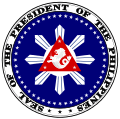 | |
| Reference style | His Excellency |
| Spoken style | Your Excellency |
| Alternative style | Mr. President |
| Population | |
|---|---|
| 1957 | 22.68 million |
| Gross Domestic Product | |
| 1957 |
|
| 1961 |
|
| Growth rate, 1957-61 | 4.6% |
| Per capita income | |
| 1957 |
|
| 1961 |
|
| Total exports | |
| 1957 |
|
| 1961 |
|
| Exchange rates | |
|
1 US US$ = Php 2.64 1 Php = US US$ 0.38 | |
|
Sources: Philippine Presidency Project Malaya, Jonathan; Eduardo Malaya. So Help Us God... The Inaugurals of the Presidents of the Philippines. Anvil Publishing, Inc. | |
Accession
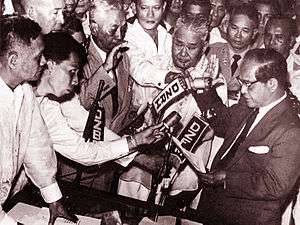
At the time of President Magsaysay's sudden death on March 17, 1957, Garcia was heading the Philippine delegation to the SEATO conference then being held at Canberra, Australia.[4] Having been immediately notified of the tragedy, Vice President Garcia enplaned back for Manila. Upon his arrival he directly repaired to Malacañang Palace to assume the duties of President. Chief Justice Ricardo Paras, of the Supreme Court, was at hand to administer the oath of office. President Garcia's first actions dealt with the declaration of a period of mourning for the whole nation and the burial ceremonies for the late Chief-Executive Magsaysay.[4]
Anti-Communism
After much discussion, both official and public, the Congress of the Philippines, finally, approved a bill outlawing the Communist Party of the Philippines. Despite the pressure exerted against the congressional measure, President Carlos P. Garcia signed the said bill into law as Republic Act No. 1700 on June 19, 1957.[4][5]
Republic Act № 1700 was superseded by Presidential Decree № 885, entitled "Outlawing Subversive Organization, Penalizing Membership Therein and For Other Purposes." This was amended by Presidential Decree № 1736, and later superseded by Presidential Decree № 1835, entitled, "Codifying The Various Laws on Anti-Subversion and Increasing the Penalties for Membership in Subversive Organization." This, in turn, was amended by Presidential Decree № 1975. On May 5, 1987, Executive Order № 167 repealed Presidential Decrees № 1835 and № 1975 as being unduly restrictive of the constitutional right to form associations.[6]
On September 22, 1992, Republic Act № 1700, as amended, was repealed by Republic Act № 7636.[7]
Filipino First Policy
President Garcia exercised the Filipino First Policy, for which he was known. This policy heavily favored Filipino businessmen over foreign investor. He was also responsible for changes in retail trade which greatly affected the Chinese businessmen in the country. In a speech during a joint session of Congress on September 18, 1946, President Garcia said the following:
| “ | We are called upon to decide on this momentous debate whether or not this land of ours will remain the cradle and grave, the womb and tomb of our race – the only place where we can build our homes, our temples, and our altars and where we erect the castles of our racial hopes, dreams and traditions and where we establish the warehouse of our happiness and prosperity, of our joys and sorrows.[8] | ” |
Austerity Program
In the face of the trying conditions of the country, President Garcia initiated what has been called "The Austerity Program". His administration was characterized by its austerity program and its insistence on a comprehensive nationalist policy. On March 3, 1960, he affirmed the need for complete economic freedom and added that the government no longer would tolerate the dominance of foreign interests (especially American) in the national economy. He promised to shake off "the yoke of alien domination in business, trade, commerce and industry." Garcia was also credited with his role in reviving Filipino cultural arts.[3] The main points of the Austerity Program were:[4]
- The government would tightened up its controls to prevent abuses in the over shipment of exports under license and in under-pricing as well.
- There would be a more rigid enforcement of the existing regulations on barter shipments.
- Government imports themselves were to be restricted to essential items.
- The government also would reduce rice imports to a minimum.
- An overhauling of the local transportation system would be attempted so as to reduce the importation of gasoline and spare parts.
- The tax system would be revised so as to attain more equitable distribution of the payment-burden and achieve more effective collection from those with ability to pay.
- There would be an intensification of food production.
The program was hailed[4] by the people at large and confidence was expressed that the measures proposed would help solve the standing problems of the Republic.[4]
Bohlen–Serrano Agreement
During his administration, he acted on the Bohlen–Serrano Agreement, which shortened the lease of the American Bases from 99 years to 25 years and made it renewable after every five years.
1961 Presidential Election
At the end of his second term, he ran for re–election in the Presidential elections in November 1961, but was defeated by his Vice-President Diosdado Macapagal, who belonged to the opposing Liberal Party (the President and the Vice-President are elected separately in the country).
Cabinet
| |||||||||||||||||||||||||||||||||||||||||||||||||||||||||||||||||||||||||||||||||||||||||||||||||||
Post-Presidency and Death

After his failed re–election bid, Garcia retired to Tagbilaran to resume as a private citizen.
On June 1, 1971, Garcia was elected delegate of the 1971 Constitutional Convention. The convention delegates elected him as the President of the Convention. However, just days after his election, on June 14, 1971, Garcia died from a fatal heart attack on 5:57 p.m. at his residence in Bohol Avenue (now Sgt. Esguerra Avenue), Quezon City.[9] He was succeeded as president of the Convention by his former Vice-President, Diosdado Macapagal.
Garcia became the first layman to lie in state in Manila Cathedral—a privilege until then limited to a deceased Archbishop of Manila—and the first President to be buried at the Libingan ng mga Bayani.
Honors
Foreign Honors
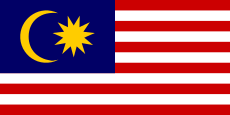 Malaya: Honorary Recipient of the Order of the Crown of the Realm (1959)[10]
Malaya: Honorary Recipient of the Order of the Crown of the Realm (1959)[10] .svg.png) Spain: Knight of the Collar of the Order of Civil Merit (October 1, 1957)[11]
Spain: Knight of the Collar of the Order of Civil Merit (October 1, 1957)[11]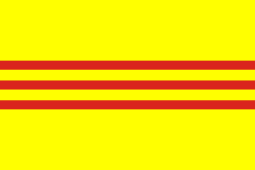 South Vietnam: Kim Khanh Medal (March 19, 1956)[12]
South Vietnam: Kim Khanh Medal (March 19, 1956)[12]
References
- 1 2 "Remembering Carlos P. Garcia on his 115th Birth Anniversary" Archived January 11, 2013, at the Wayback Machine.. Manila Bulletin. Retrieved 2012-10-05.
- ↑ "List of Previous Senators". Senate of the Philippines. Retrieved November 22, 2014.
- 1 2 Eufronio Alip, ed., The Philippine Presidents from Aguinaldo to García (1958); Jesús V. Merritt, Our Presidents: Profiles in History (1962); and Pedro A. Gagelonia, Presidents All (1967). See also Hernando J. Abaya, The Untold Philippine Story (1967). Further information can be found in Ester G. Maring and Joel M. Maring, eds., Historical and Cultural Dictionary of the Philippines (1973).
- 1 2 3 4 5 6 Molina, Antonio. The Philippines: Through the centuries. Manila: University of Sto. Tomas Cooperative, 1961. Print.
- ↑ "Republic Act No. 1700". Chan Robles Law Library. June 19, 1957.
- ↑ "Executive Order No. 167, Series of 1987". Chan Robles Law Library. May 5, 1987.
- ↑ "Republic Act No. 7636". Chan Robles Law Library. September 22, 1992.
- ↑ "Our Vision and Mission". prescarlosgarcia.org.
- ↑ "CPG IS DEAD!". The Bohol Chronicle. June 15, 1971. Retrieved September 13, 2016.
- ↑ "Senarai Penuh Penerima Darjah Kebesaran, Bintang dan Pingat Persekutuan Tahun 1959." (PDF).
- ↑ "Filipino recipients of Spanish Decorations". Official Gazette of the Republic of the Philippines.
- ↑ "President's Month in Review: March 16 – March 31, 1958". Official Gazette of the Republic of the Philippines.
- Zaide, Gregorio F. (1984). Philippine History and Government. National Bookstore Printing Press.
External links
![]() Works written by or about Carlos P. Garcia at Wikisource
Works written by or about Carlos P. Garcia at Wikisource
-
 Media related to Carlos P. Garcia at Wikimedia Commons
Media related to Carlos P. Garcia at Wikimedia Commons - Carlos P. Garcia on the Presidential Museum and Library
| Political offices | ||
|---|---|---|
| Preceded by Fernando Lopez |
Vice President of the Philippines 1953–1957 |
Vacant Title next held by Diosdado Macapagal |
| Preceded by Ramon Magsaysay |
President of the Philippines 1957–1961 |
Succeeded by Diosdado Macapagal |
